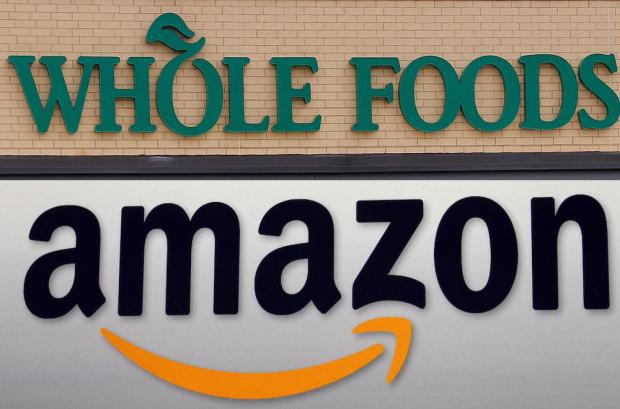Sizzle Of The Week: Amazon Solves The Last Mile Problem With Whole Foods

This week, in honor of the Big Sizzle – Amazon’s announcement that it would be offering grocery delivery directly from Whole Foods – we thought we would give our readers a chance to take a special quiz.
- “THUD”
The above is the sound of…
- The other shoe
- dropping on Amazon’s August 2017 Whole Foods purchase.
- The stock prices
- of Walmart, Kroger, Target and Publix all crashing at once.
- Scores of Prime
- members fainting, overwhelmed by prospect of Whole Foods coming to them – for free!
- A and B
- All of the
- above
See the end of the story for the answer.*
When Amazon officially forked over nearly $14 billion in August of 2016 to acquire Whole Foods, everyone knew one thing – and had one question.
What everyone knew was that the stakes in the growing war for grocery dominance in the U.S, had just entered a whole new phase – and one that was very likely to be defined by Amazon.
The question: Now what?
Theories abounded. Price cutting was the favorite – and price cuts did indeed follow, most notably during the holiday season. A big boost for both firms’ private-label brands was forecast, and has since come to pass.
But six months ago, in Karen Webster’s crystal ball reading on the subject, she noted that while pricing, product and private labels were in the mix and were all going to be critical to Amazon’s ability to “gut” traditional grocery as we know it, her theory was that in the end, it might just be all about those Prime members.
“The way to Amazon’s food commerce heart is through the stomachs of its Prime members,” Webster noted.
As it turns out, she had a point. Because Amazon’s expanded delivery program, which will run directly from Whole Foods, isn’t an expansion of Amazon Fresh – it’s an expansion of Amazon Prime Now.
As of yesterday, Amazon had officially announced that Prime members in proximity to Whole Foods have a very special new perk coming their way: free grocery delivery within two hours, or a one-hour delivery for a small charge.
So far, the Whole Foods/Prime Now delivery footprint is small, with service in only four U.S. cities – Austin, Cincinnati, Dallas and Virginia Beach – but nationwide rollout is scheduled by the end of the year.
According to the Amazon/Whole Foods release, customers will be able to pick from fresh meat, seafood, flowers and “most” of the items stocked in their local Whole Foods locations.
Amazon, the experts note, has done many things with this announcement. First, and most obviously, the level of the game just went up for every other player in the grocery.
But, analysts noted, Amazon has also taken their “last mile” problem and upended it entirely. Instead of trying to figure out the last few logistical steps of getting fresh grocery goods from a remote warehouse to a customer’s door, Amazon has turned Whole Foods locations into a warehouse of sorts, and made the last mile the first mile.
And while the program is starting with Whole Foods grocery offerings, segment watchers are wondering what other applications might be next. Some have speculated that Amazon is planning a serious restructuring plan for Whole Foods stores, which could see whole sections of the stores converted into miniature versions of Amazon’s highly automated warehouses.
As a few analysts have noted, this could be one of the many moves Amazon is in the process of undertaking to ensure that their supply chain is as close to its customers as possible, while still being largely invisible to them.
But let’s not get too far out ahead of our ski. Even if Amazon is only delivering groceries – and a big fat benefit to its Prime members – as Karen Webster noted, that might just be enough to start a whole new retail death spiral, spinning off a whole new Amazon flywheel.
“It’s about signaling that Amazon Prime customers will soon get lots of benefits when they use their Prime accounts – a.k.a. Amazon Pay – to check out (or to check in?) at Whole Foods,” she said. “And how that enormous – and enormously Prime loyal consumer base – will shake up how, when and where all organic foods, not just groceries, are purchased, paid for and eaten.”
And that is surely enough to win sizzle of the week.
Oh, and about that quiz …
The answer was A – the sound of the other shoe dropping.
- The sound of grocery stocks dropping is also true, but given that the stock market fell 1,000 points today, we don’t think it is quite fair to blame the grocery segment’s performance on Amazon, whose stock price also fell.
- The sound of enraptured fainting. While many Facebook accounts were woozy over the news, so far as we know, no one actually lost consciousness.
But surely enough to earn it the Sizzle of the Week, hands down.
Sizzle
Regulations for crypto: Price volatility proves a boon for regulation, and this should be little surprise to anyone. Beyond China and South Korea, and here in the States, Treasury Secretary Steve Mnuchin and team are ramping up efforts to get regulations in place. Lots of agencies are getting involved, such as the SEC. Smells like a slew of bills – of the legislative sort – may be coming our way.
Steve Mnuchin: For diplomatically telling the Justice Department to please let them digitize pot payments, and equally diplomatically telling the CFPB to please help with the Equifax hack investigation.
FinTech licensing: This gets streamlined a bit, as seven states sign a deal that makes it easier to offer services on a nationwide basis. It’s a start, with a nod to process. If one state gives the thumbs-up for certain services to be provided, the others will as well. Coordination fosters a level playing field for innovation – who’da thunk it?
In-store pickup for app orders: Despite growing pains, such as deciding whether to offer curbside pickup or other offerings, some technology adoption by QSRs stands out, according to the latest PYMNTS Restaurant Readiness Index. Consider the fact that slightly less than half of QSR offer a “pickup in store” feature for mobile apps.
Fizzle
HomePod: The reviews are in and they are not glowing – in fact, they’re mixed. Sound matters, and here the sound is less than stellar. The limited ecosystem may staunch adoption, as well – confined, perhaps, to the Apple products that users already know (and ostensibly love). The Wall Street Journal has noted that competing speakers, with similar (or better) sound quality and relatively more affordable prices, are available, such as the Echo or the Sonos.
No accounts are safe: Direct deposit … right into the hackers’ wallets. Bad guys have been using a phishing scam to target employees at firms and grab hold of their paychecks, before said paychecks hit accounts. Talk about coming up short when the rent is due.
KodakCoin: Mama, don’t take my KodakCoin away. Scammers are scamming away to make a less than picture-perfect mess out of one of the latest cryptos to make headlines. So messy, in fact, that the KodakCoin ICO is being delayed because every investor needs to be vetted. This is negative exposure the once-dominant force in film never needed.
Rural banking: Branches are evaporating in regions where consumers are least likely to replace them with digital banking.
Tech stock: In what was a significantly bad week in the stock market, these guys did particularly badly.
